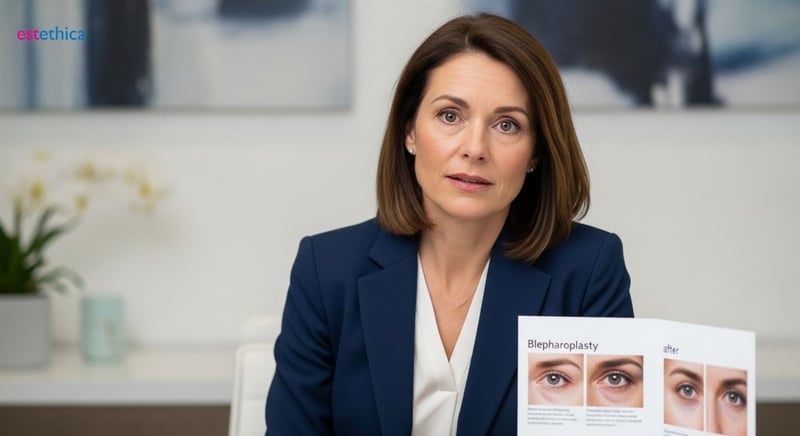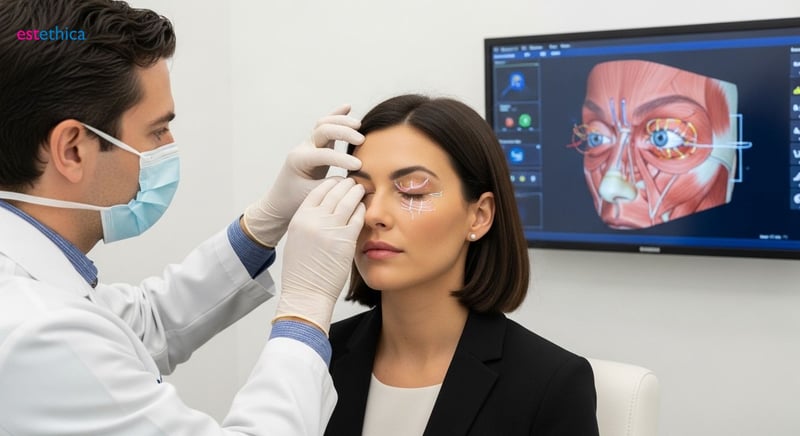Unlock Youthful Eyes: The Ultimate Guide to Eyelid Surgery
Explore eyelid rejuvenation options that blend aesthetic appeal with functional benefits. Our guide to eyelid lifts, upper and lower surgeries, and more ensures a youthful look.
Eyelid rejuvenation is a transformative cosmetic procedure that goes beyond enhancing your appearance. It addresses both aesthetic desires and functional needs, offering a comprehensive approach to facial rejuvenation. This guide delves into the essentials of eyelid rejuvenation, exploring the differences between upper and lower eyelid surgeries, the benefits, the procedure expectations, and who makes an ideal candidate. Embrace the journey to youthful eyes with informed decisions and confidence.
Beyond Aesthetics: Understanding the Functional Benefits of Eyelid Lift
The Multifaceted Advantages of Blepharoplasty
Eyelid lifts, scientifically known as blepharoplasty, extend beyond mere cosmetic enhancements, offering substantial functional improvements that can significantly enhance a patient's quality of life. The primary goal of cosmetic eyelid surgery is often to rejuvenate the area around the eyes, addressing concerns such as sagging skin, puffiness, and wrinkles. However, the benefits of blepharoplasty reach much further, providing relief from physical discomfort and improving visual acuity. For instance, drooping upper eyelids can obstruct the field of vision, making everyday tasks like reading or driving difficult. By correcting this issue through upper eyelid surgery, patients often experience a noticeable improvement in their sight. In fact, studies have shown that approximately 70% of patients report enhanced vision following blepharoplasty, highlighting its effectiveness in addressing functional impairments.
- Improved Vision: Correcting droopy eyelids can significantly expand the visual field, enhancing overall clarity.
- Reduced Headaches: Relieving the strain on forehead muscles reduces tension headaches associated with constant brow lifting.
- Enhanced Comfort: Eliminating excess skin reduces irritation and discomfort, improving daily life quality.
Functional Improvements Through Eyelid Surgery
Beyond aesthetic enhancements, eyelid lift procedures are pivotal in addressing functional impairments caused by aging or genetic factors. Upper eyelid surgery, for example, can alleviate the discomfort and visual obstruction caused by ptosis, where the eyelid droops to cover part of the pupil. This condition not only affects vision but can also lead to chronic headaches due to the constant effort required to lift the eyebrows. Lower eyelid surgery can correct issues like ectropion (where the eyelid turns outward) or entropion (where the eyelid turns inward), both of which can cause irritation, dryness, and potential damage to the cornea. Cosmetic eyelid surgery addresses these concerns, improving eye health and comfort. Blepharoplasty, therefore, is a multifaceted procedure that provides both cosmetic and functional benefits, improving patients' overall well-being.
- Initial Consultation: A comprehensive evaluation to determine the extent of visual impairment and suitability for surgery.
- Surgical Procedure: Precise removal of excess skin and tissue to restore optimal eyelid function and appearance.
- Post-Operative Care: Careful monitoring and aftercare to ensure proper healing and long-term functional benefits.

Upper vs. Lower Eyelid Surgery: Which Procedure Is Right for You?
Key Differences Between Upper and Lower Blepharoplasty
Deciding between upper and lower eyelid surgery hinges on addressing specific aesthetic and functional concerns. Upper blepharoplasty primarily targets the removal of excess skin on the upper eyelids. This excess skin can sometimes impair vision or create a perpetually tired appearance. The procedure involves carefully excising redundant skin and, if necessary, repositioning underlying fat to create a smoother, more youthful upper eyelid contour. In contrast, lower blepharoplasty focuses on reducing puffiness and bags under the eyes. This is achieved by either removing or repositioning the fat pads that accumulate in the lower eyelid area. Sometimes, excess skin is also removed to tighten the lower eyelid and reduce wrinkles. Understanding these distinctions is crucial for individuals considering eyelid surgery, as it ensures that the chosen procedure aligns with their unique needs and goals.
- Upper Blepharoplasty: Addresses excess skin and vision impairment.
- Lower Blepharoplasty: Targets puffiness and bags under the eyes.
- Customized Approach: Tailored to individual aesthetic and functional goals.
Determining the Right Procedure for Your Needs
Choosing between upper and lower eyelid surgery involves a thorough evaluation of your specific concerns and desired outcomes. If you are experiencing drooping upper eyelids that obstruct your vision or give you a tired look, upper blepharoplasty may be the most suitable option. This procedure can dramatically improve your field of vision and rejuvenate your appearance. On the other hand, if your primary concern is puffiness or bags under your eyes that make you look older or more tired, lower blepharoplasty may be the better choice. Some individuals may benefit from a combination of both upper and lower blepharoplasty to achieve comprehensive eyelid rejuvenation. A consultation with a qualified cosmetic surgeon is essential to assess your individual needs and determine the most appropriate surgical plan. For example, someone with significant upper eyelid sagging and lower eyelid bags might opt for a combined approach to achieve a balanced and harmonious result, ensuring that the upper and lower eyelids complement each other aesthetically.
- Assess Concerns: Identify primary issues like drooping or puffiness.
- Consult Surgeon: Get a professional evaluation for tailored advice.
- Consider Combined Approach: Explore options for comprehensive rejuvenation.

Blepharoplasty Unveiled: What to Expect Before, During, and After Surgery
Navigating the Blepharoplasty Journey: A Step-by-Step Guide
Embarking on a blepharoplasty journey involves several key stages, each designed to ensure the best possible outcome. The initial consultation is crucial, where prospective patients meet with a surgeon to discuss their goals and assess their suitability for the procedure. This involves a comprehensive evaluation of the patient's health history and a detailed examination of the eyelids. The surgeon explains the different techniques available, potential risks, and realistic expectations. The surgical phase typically involves either local or general anesthesia, depending on the complexity of the case and the patient's preference. Incisions are carefully placed along natural creases of the eyelids to minimize visible scarring. Excess skin, fat, and muscle are then removed or repositioned to achieve a smoother, more youthful appearance. Postoperative care is vital for proper healing and optimal results. Patients receive detailed instructions on wound care, pain management, and follow-up appointments to monitor their progress.
- Initial Consultation: Discuss goals and assess suitability.
- Surgical Phase: Precise incisions and tissue removal.
- Postoperative Care: Wound care and follow-up.
Understanding the Costs Associated with Eyelid Surgery
When considering cosmetic eyelid surgery, it's important to understand the various costs associated with the procedure. While prices vary depending on geographic location, surgeon's fees, and the complexity of the surgery, understanding what influences these costs can help you make an informed decision. For instance, procedures performed in metropolitan areas like New York or Los Angeles may have higher costs due to increased overhead and demand. The surgeon's experience and qualifications also play a significant role, with highly skilled and board-certified surgeons typically charging more for their expertise. The type of anesthesia used, whether local or general, can also affect the overall cost. Additionally, the extent of the surgery, such as whether you're undergoing upper eyelid surgery, lower eyelid surgery, or a combination of both, will influence the final price. Blepharoplasty procedures require careful planning and execution, and choosing a qualified surgeon is essential for achieving satisfactory results.
- Surgeon's Fees: Varies based on experience and qualifications.
- Anesthesia Type: Local or general anesthesia options.
- Extent of Surgery: Upper, lower, or combined eyelid procedures.

Candidacy Check: Are You the Ideal Candidate for Cosmetic Eyelid Surgery?
Essential Factors for Eyelid Surgery Candidacy
Determining whether you are an ideal candidate for cosmetic eyelid surgery involves evaluating several key factors to ensure both safety and satisfaction with the results. The best candidates typically include individuals who are in good general health, without any underlying medical conditions that could complicate the surgical procedure or hinder the healing process. For instance, uncontrolled diabetes or certain autoimmune disorders can increase the risk of complications. A comprehensive medical evaluation by a qualified surgeon is essential to assess your overall health status and determine if any pre-existing conditions need to be managed before undergoing surgery. Additionally, it's important to have realistic expectations about what eyelid surgery can achieve. While blepharoplasty can significantly improve the appearance of the eyelids and address functional issues, it's not a one-size-fits-all solution and results can vary depending on individual factors such as skin elasticity and underlying facial structure. Consulting with a skilled and experienced surgeon will help you understand the potential benefits and limitations of the procedure, ensuring that you make an informed decision about whether it's right for you.
- Good General Health: Absence of significant medical conditions.
- Realistic Expectations: Understanding the achievable outcomes.
- Comprehensive Evaluation: Thorough assessment by a qualified surgeon.
Assessing Your Candidacy for Blepharoplasty
Evaluating your candidacy for blepharoplasty involves a detailed assessment of both your physical and psychological preparedness. Ideal candidates are typically those who have specific, well-defined goals for improving the appearance or function of their eyelids. For example, someone bothered by severe drooping of the upper eyelids that impairs vision, or those with significant bags under their eyes that create a perpetually tired appearance, may find blepharoplasty to be a suitable solution. It's also important to have a stable emotional state and a clear understanding of the surgical process, including the potential risks and recovery period. Patients who are well-informed and mentally prepared tend to have better outcomes and higher satisfaction rates. During the consultation, the surgeon will assess the anatomical structure of your eyelids, evaluate skin quality, and discuss your aesthetic goals to determine the most appropriate surgical approach. Additionally, they will review your medical history to identify any factors that could affect your candidacy, such as a history of dry eye syndrome or previous eye surgeries. This thorough evaluation ensures that blepharoplasty is a safe and effective option for you.
- Define Goals: Identify specific improvements you desire.
- Emotional Stability: Be mentally prepared for the process.
- Medical Review: Disclose any relevant health history.
Precision Blepharoplasty: Achieving Functional Vision Improvement and Aesthetic Rejuvenation
estethica employs advanced blepharoplasty techniques, including precise removal and repositioning of excess skin, fat, and muscle, tailored to individual patient needs. Both upper and lower eyelid surgeries are performed with meticulous attention to detail, ensuring minimal scarring and optimal aesthetic outcomes.
estethica's surgeons are highly skilled and experienced in cosmetic eyelid surgery, with a deep understanding of facial anatomy and aesthetic principles. Their expertise extends to both functional and cosmetic aspects of blepharoplasty, ensuring comprehensive patient care.
Comprehensive Patient Care: From Initial Consultation to Post-Operative Monitoring
estethica provides a step-by-step guide for blepharoplasty, ensuring patients are well-informed and prepared for each stage of the process. The hospital emphasizes comprehensive pre-operative assessments, detailed surgical planning, and attentive post-operative care to ensure optimal healing and patient satisfaction.
Patients at estethica benefit from personalized treatment plans and a supportive environment, resulting in improved aesthetic outcomes and enhanced quality of life. The hospital’s commitment to patient safety and satisfaction is evident in the positive experiences reported by those who have undergone blepharoplasty.
Frequently Asked Questions
What is Eyelid Lift (Blepharoplasty) and what does it address?
What is the difference between Upper Eyelid Surgery and Lower Eyelid Surgery?
What can I expect during the Blepharoplasty surgical procedure?
What are the functional benefits of undergoing Cosmetic Eyelid Surgery?
How do I know if I am a good candidate for an Eyelid Lift?
Ready to discover your healthiest, most beautiful self with estethica's personalized care?
📞 Call Now for Your Free Consultation!